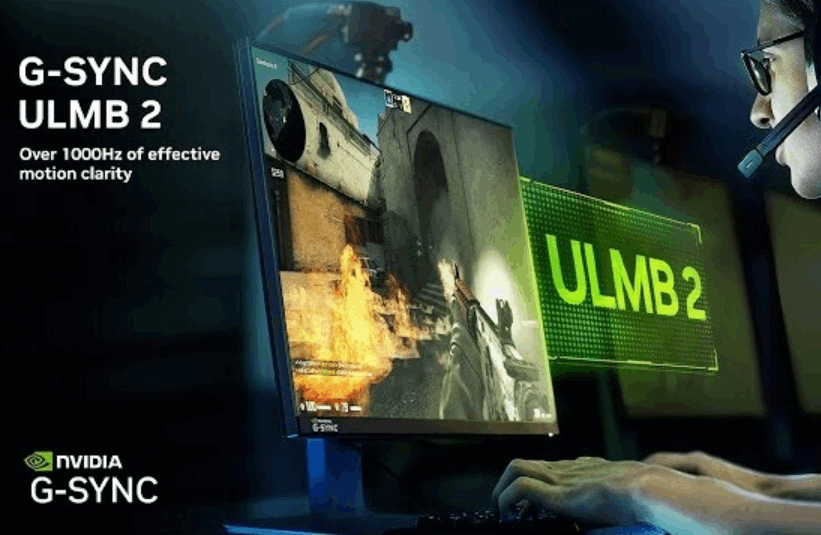NVIDIA has unveiled G-SYNC Ultra Low Motion Blur (ULMB), a groundbreaking technique incorporated in G-SYNC monitors to enhance motion clarity during intense gaming sessions.
Building upon this success, we are now proud to announce the launch of G-SYNC Ultra Low Motion Blur 2 (ULMB 2), which offers an effective motion clarity of over 1000 Hz, providing competitive gamers with the ultimate motion blur reduction experience. In comparison to its predecessor, ULMB 2 offers the benefits of full refresh rate backlight strobing, significantly increased brightness, and virtually zero crosstalk. ULMB 2 is now readily available for compatible 1440p 360 Hz G-SYNC monitors through a simple, one-click firmware updater, and it's completely free of charge.
When NVIDIA initially introduced the ULMB technology back in 2015, monitor response times, referring to the duration it took for a pixel to transition between colors, were relatively sluggish. This resulted in noticeable ghosting and blurry images, leading to a subpar level of motion clarity. Motion clarity can be described as the ability to clearly perceive and comprehend objects in motion. Superior motion clarity is characterized by sharp edges and well-defined details, devoid of blurriness. To address this issue and enhance motion clarity, ULMB implemented a technique known as backlight strobing (further elaborated below). To achieve backlight strobing, ULMB disables the backlight 75% of the time. This 25% duty cycle on a max 300 nit panel meant that the images would be clear, but less bright. With the original ULMB, we would need to wait longer for the pixels to transition to the right place before turning on the backlight due to the slower pixel response times in 2015. To compensate, ULMB would reduce the refresh rate to give the pixels more time to transition. Because of these drawbacks, competitive gamers often chose not to use the feature as the full refresh rate and bright image were more desirable.
Enter G-SYNC Ultra Low Motion Blur 2 (ULMB 2)
ULMB 2 provides full refresh rate backlight strobing and significantly brighter images, all while maintaining pristine image quality. With the panel response time improvements from our partners at AUO, ULMB 2 gives competitive gamers the motion clarity needed to perform at peak levels by keeping them in the game when moments get chaotic. With ULMB 2, gamers get an effective motion clarity of over 1000 Hz with these improvements, calculated as the refresh rate of the monitor multiplied by one over the duty cycle [Effective Motion Clarity = Refresh rate * (1 / Duty Cycle)]. For a 360 Hz monitor with ULMB 2, the effective motion clarity is actually 1440 Hz. That means in order to obtain the same level of motion clarity without ULMB 2, gamers would need a classic panel capable of 1440 Hz.
To show this in action, we set up a test panel in our lab. Below is an example of a 120 Hz monitor with backlight strobing compared to a 480 Hz monitor without backlight strobing: Effective Motion Clarity = 480 Hz = 120*(1/0.25).
How Does ULMB 2 Work?
First, let's explain how LCD panels work. LCD panels consist of two main layers:
- The liquid crystal pixels, which chemically change to adjust the color of light shining through them
- The backlight, which produces the light that shines through the pixels
When a new frame needs to be displayed on the monitor, a new color value is sent to each pixel. At this point, the pixel will start to transition to its new color over time. During this process, the backlight is on the entire time so the gamer visually sees the full transition. In addition, the image is "held" before and after transition which causes the human visual system to blur the two images together. The combination of the "motion hold" and visible transition is what causes display-based motion blur (not to be confused with an in-game motion blur setting). With ULMB 2, the backlight is only turned on when each pixel is at its correct color value. The idea is to not show the pixels transitioning, and only show them when their color is accurate. But this technique creates a challenge: backlights generally light up all pixels at the same time where pixels are changed on a rolling scanout. At any given point in time, a portion of the screen will have double images (as known as crosstalk). The solution to this problem is what sets G-SYNC's ULMB 2 apart from other backlight strobing techniques: with G-SYNC, we're able to control the response time depending on where the vertical scan is, such that the pixels throughout the panel are at the right level at precisely the right time for the backlight to be flashed. We call this "Vertical Dependent Overdrive".
With Vertical Dependent Overdrive, ULMB 2 delivers great image quality even at high refresh rates where the optimal window for backlight strobing is small.
ULMB 2 Is Available Now
For ULMB 2 capability, monitors must meet the following requirements:
- Deliver over 1000 Hz of effective motion clarity
- Drive ULMB 2 at the monitor's full refresh rate
- Deliver over 250 nits of brightness with minimal crosstalk or double images
Already, two ULMB 2 capable monitors are on the market, and another two are launching in the near future:
Available Today:
- Acer Predator XB273U F - 27" 1440p 360 Hz
- ASUS ROG Swift 360Hz PG27AQN - 27" 1440p 360 Hz
Available Soon:
- ASUS ROG Swift Pro PG248QP - 25" 1080p 540 Hz
- AOC AGON AG276QSG G-SYNC Monitor - 27" 1440p 360 Hz


